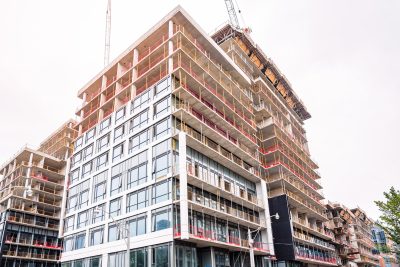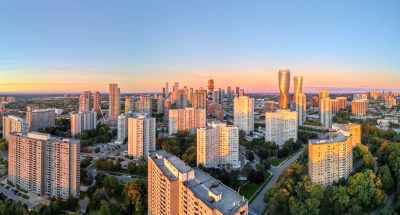Housing Neglect and Housing Loss
 Across the country, renters are facing increasingly precarious conditions. Over 22 per cent of renters are living in core housing need, meaning that their housing is unaffordable, in need of major repairs (inadequate housing), and/or overcrowded (unsuitable housing). Nearly 17 per cent of households in core housing need experience issues related to repairs and maintenance and close to 10 per cent live in overcrowded conditions. Inadequate housing is most prevalent in Ontario and British Columbia, and disproportionately impacts low income households, particularly racialized households, Indigenous communities, women and gender-diverse people, and people with disabilities. Renters living in substandard housing are often forced to leave their homes, as they are no longer habitable or safe to live in. As a result, they are more likely to experience homelessness.
Across the country, renters are facing increasingly precarious conditions. Over 22 per cent of renters are living in core housing need, meaning that their housing is unaffordable, in need of major repairs (inadequate housing), and/or overcrowded (unsuitable housing). Nearly 17 per cent of households in core housing need experience issues related to repairs and maintenance and close to 10 per cent live in overcrowded conditions. Inadequate housing is most prevalent in Ontario and British Columbia, and disproportionately impacts low income households, particularly racialized households, Indigenous communities, women and gender-diverse people, and people with disabilities. Renters living in substandard housing are often forced to leave their homes, as they are no longer habitable or safe to live in. As a result, they are more likely to experience homelessness.
Maintenance and upkeep are essential to preserving Canada’s affordable housing stock and preventing displacement and homelessness. Estimates show that for every home built under government-funded programs, Canada loses 11 affordable rental homes, some of which are lost through building neglect. Neglecting maintenance and repairs often leads to the rapid deterioration of the rental housing stock and opens the door to renter displacement through renovictions and demovictions. In addition, structurally unsound housing, the presence of mould or pests, extreme temperatures and lack of access to safe drinking water and proper sanitation have serious and long-lasting impacts on renters’ health.
The majority of Canada’s rental housing stock was built before 1980. While the useful life cycle of residential buildings is generally considered to be between 45 and 65 years, some of the oldest housing stock has stood the test of time through investments in maintenance and repairs. Even so, in recent years, a portion of that stock has fallen into such a state of disrepair that it needs to be demolished or undergo major renovations. In the absence of strong rental replacement policies focused on affordability and tenure security for renters, the new housing built in its place is usually unaffordable. To preserve Canada’s crucial existing affordable housing stock, property owners must continuously invest in upkeep and repair.
 In an increasingly financialized rental housing market, redevelopment is becoming a more common business model, especially for financialized landlords who see the acquisition of old buildings as a way to maximize their profits. Under this model, landlords are incentivized to neglect building maintenance to save costs, while inadequate services and deteriorating conditions also serve to push existing renters out of their homes to raise rents. To mitigate these circumstances, governments must enforce robust maintenance and repair standards to protect both renters and the existing affordable housing stock.
In an increasingly financialized rental housing market, redevelopment is becoming a more common business model, especially for financialized landlords who see the acquisition of old buildings as a way to maximize their profits. Under this model, landlords are incentivized to neglect building maintenance to save costs, while inadequate services and deteriorating conditions also serve to push existing renters out of their homes to raise rents. To mitigate these circumstances, governments must enforce robust maintenance and repair standards to protect both renters and the existing affordable housing stock.
Enforcement of Property Standards
Inadequate housing is widespread in Ontario, where 85 per cent of all purpose-built rentals are over 45 years old and roughly one quarter of renter applications to the Landlord and Tenant Board (LTB) are related to maintenance issues.
Building codes and property standards set out the minimum requirements for provinces and municipalities to ensure homes are structurally safe and in good condition. At the provincial level, the Ontario Building Code and the Residential Tenancies Act (RTA) are the key pieces of legislation regulating the physical condition of dwellings, sanitation, fire safety, plumbing, heating, and issues related to mould and pests. All property owners have an obligation to meet these standards to guarantee the health and safety of building occupants. Effective enforcement of building and property standards also extends the life cycle of residential buildings by ensuring aging buildings are “up to Code.”
Under the RTA, property owners found in non-compliance with their obligations related to building standards may be required to undertake maintenance work or renovations, and/or to compensate renters for any costs incurred for repairs or damage. Landlords are also prohibited from increasing rents for existing or new renters until repairs have been completed.
However, it can take up to two years for an application for maintenance issues to be resolved at the LTB. In addition, some forms of deeply affordable housing are not covered under the RTA, such as when renters share a kitchen or bathroom with their landlord. Moreover, enforcement of property standards is overly reliant on renter-initiated complaints, and long processing times mean that renters have to bear the costs of repair or continue living in deteriorating conditions. Municipalities can help improve rental housing conditions by implementing local property standards enforcement programs that rely on proactive inspections.
Rental Housing Licensing
 Municipal codes contain property standards bylaws that include requirements for building owners and operators related to property cleanliness, pest management, repairs, and more. While it is important to have legal requirements that outline landlords’ obligations around maintenance and repairs, it is equally important to have strong enforcement and accountability mechanisms to ensure that building owners and operators comply with those requirements.
Municipal codes contain property standards bylaws that include requirements for building owners and operators related to property cleanliness, pest management, repairs, and more. While it is important to have legal requirements that outline landlords’ obligations around maintenance and repairs, it is equally important to have strong enforcement and accountability mechanisms to ensure that building owners and operators comply with those requirements.
Rental housing licensing is a proactive, effective and efficient way that local governments can ensure buildings are maintained in a state of good repair. Such programs shift the onus off renters from having to make a complaint in order for their homes to be well maintained. Under this model, landlords must obtain rental housing licenses that are subject to building evaluations and regular health and safety inspections to demonstrate compliance with municipal property standards. Several municipalities in Ontario have adopted a form of rental licensing program, with varying degrees of success.
A) RentSafeTO
Adopted in 2017, the City of Toronto’s RentSafeTO builds on the legacy of the previous Multi-Residential Apartment Buildings (MRAB) program established in 2008, and is the first rental licensing program in Ontario that attempts to proactively enforce municipal property standards.
While property standards must be enforced under the City’s Municipal Code regardless of RentSafeTO, enforcement only occurs if a renter makes a complaint. Bylaw enforcement officers review and investigate complaints and can issue work orders and/or fines to landlords found in non-compliance. This kind of reactive enforcement program puts the onus on renters to ensure their health and safety in the home. Many renters may have difficulty placing a complaint, as they might not be aware of their rights or might fear being evicted for raising concerns with their landlord.
The RentSafeTO program puts the onus on landlords to comply with the City’s standards for housing safety and maintenance. Under RentSafeTO, every apartment building with 10 or more units and three or more storeys must be registered. Landlords must meet several additional requirements under the program, including annual renewal of their license, tracking and responding to service requests, preparing a capital plan detailing all necessary repairs for the next five years, sharing maintenance updates with renters, and undergoing building inspections every two years.
After the initial building evaluation, bylaw enforcement teams determine a building score reflecting the physical state of the building and the level of compliance with municipal property standards. Landlords must display their building score on a tenant notification board, along with information on the next evaluation or audit, and how to submit a service request to the City. In addition, the City has an online interactive map to make that information easily accessible. Buildings with the lowest scores must undergo a full audit, after which bylaw enforcement officers might issue an Order to Comply or Notice of Violation, and landlords may face fines of up to $100,000 for non-compliance.
Progress reports on RentSafeTO show that rental licensing programs can be effective in proactively addressing maintenance issues. As of 2023, 89 per cent of service requests were investigated and resolved by RentSafeTO’s bylaw enforcement team, and 95 per cent of emergency service requests were addressed within 24 hours.
However, reports from ACORN show that between 2016 and 2023, rental housing conditions in Toronto seldom improved, despite the City’s efforts to proactively regulate maintenance issues. Results from ACORN’s latest survey reveal that renters are not well informed about the RentSafeTO program. Over 37 per cent of renters have not heard about the program, close to 45 per cent of registered units did not have a tenant notification board, and 64 per cent of renters did not know if their building had been audited. Most importantly, 53 per cent of renters said that their housing conditions did not improve after an audit and 34 per cent felt threatened when trying to make a complaint about maintenance issues in their building. Recently, the City invested more funding to expand the bylaw enforcement teams, and City Council voted to strengthen the RentSafeTO program. Amendments to the bylaw include the upcoming deployment of a colour-coded rating system to better keep renters informed, as well as steeper fines for property neglect.
B) Building on the Toronto Model
 Other municipalities in Ontario have adopted their own versions of Toronto’s rental housing licensing model. Along with Toronto, Mississauga is one of the few municipalities that requires a rental housing license for multi-unit residential buildings. Mississauga’s Rental Standards Program has similar requirements as RentSafeTO overall. One significant difference is that the frequency of inspections is based on the building score. Buildings with a low score are scheduled for an audit, which may result in work orders and/or penalties, and buildings with a high score are evaluated less frequently.
Other municipalities in Ontario have adopted their own versions of Toronto’s rental housing licensing model. Along with Toronto, Mississauga is one of the few municipalities that requires a rental housing license for multi-unit residential buildings. Mississauga’s Rental Standards Program has similar requirements as RentSafeTO overall. One significant difference is that the frequency of inspections is based on the building score. Buildings with a low score are scheduled for an audit, which may result in work orders and/or penalties, and buildings with a high score are evaluated less frequently.
Most of the other municipal rental housing licensing programs target small-scale residential buildings, and follow similar conditions, with a few distinctions. In Waterloo, Hamilton, Windsor, London and Brampton, licenses are required for residential buildings of less than four to five units. Still, there are some differences between municipalities regarding the enforcement of these programs. Waterloo’s and London’s bylaws are implemented citywide, whereas Hamilton’s, Windsor’s and Brampton’s are restricted to specific wards.
For all these cities, landlords must provide information about the state of their buildings to register their property. For example, in Waterloo, landlords must submit a capital plan for repairs to obtain a license. After inspection, the City can decide to issue a work order to landlords to complete any necessary repairs, or conduct the repairs themselves and bill landlords for the costs. Landlords who do not meet the City’s property standards after receiving a notice to comply may have their licensed revoked and face fines of up to $50,000. In contrast, Hamilton, Windsor, London and Brampton only require a landlord’s self-assessment of the property. However, if upon inspection the building does not meet the City’s property standards, landlords cannot obtain a license and may face penalties if they rent their property without a license.
C) Licensing for Rooming Houses
Rental housing licensing programs ensure that residential buildings meet the minimum legal standards for health and safety. Yet these programs put into question the legality of housing options excluded from licensing requirements, which can directly impact renters’ housing security. This is often the case for rooming houses, where licensing does not offer the same rights and protections to all renters across the city.
Rooming houses, also known as multi-tenant houses (MTHs) or single-room occupancies (SROs) are a form of congregate living that has existed for over 100 years and gradually declined after World War II. In an MTH, multiple people share a single home, but they do not live together as a single household. They may share a kitchen and/or bathroom but independently rent out separate rooms. MTHs are often located in older buildings and provide one of the most affordable housing options. They are a vital element of affordable housing infrastructure and provide homes to some of the most vulnerable renters, including immigrants, newcomers, students, and other low-income and marginalized groups.
In several cities, MTHs are simply not permitted under zoning bylaws. In cities where MTH licensing exists, they may be limited to specific areas in the city. Zoning exclusions mean that many MTHs are illegally operated, which can compromise renters’ safety and security. For example, some MTH operators might continue renting rooms without investing in repair and maintenance, forcing renters to live in inadequate housing conditions. Renters living in illegal MTHs could lose their homes if they report maintenance issues, as these rooming houses could be closed by the municipality. Even in areas where MTHs are legalized, unlicensed MTH operators may be discouraged by the investments needed to comply with licensing requirements and might decide to sell or convert their property. This could lead to renter displacement through formal or informal evictions, in particular in cases where renters are not aware of their rights and of the operators’ responsibilities.
Until recently, the City of Toronto restricted MTHs to specific areas of the city, which contributed to the loss of MTHs through conversions and demolitions, while leaving renters in illegal MTHs in a legal vacuum and vulnerable to displacement. Last year, the City adopted a new Multi-Tenant Houses Regulatory Framework, which permits MTHs citywide (with some caveats) and requires landlords to obtain a Multi-Tenant Houses License. MTH operators must comply with municipal property standards and provincial Fire and Building Codes, and provide a capital plan for repairs and maintenance. Bylaw enforcement teams conduct annual inspections and licensing decisions are adjudicated through a Multi-Tenant House Licensing Tribunal, with the authority to uphold licensing decisions and issue penalties for landlords found in non-compliance.
Bringing old rental buildings up to Code can represent significant financial investments, especially for landlords operating MTHs, where rents are low and thereby rental income might be insufficient to cover repair costs. Through the Multi-Tenant Houses Renovation and Repair Program, MTH operators can access financial assistance to offset the costs of bringing properties into compliance. The program includes grants and loans for a combined maximum of $75,000, as well as waivers on planning application and building permitting fees.
While the City’s MTH framework is a promising step toward preserving affordable housing, advocates have called on the City to ensure the framework does not inadvertently lead to renter displacement or the loss of MTHs, and to implement targeted supports and protections for MTH renters.
Conclusion
Rental housing licensing programs in Ontario have proven effective in proactively enforcing adequate housing standards, as evidenced by increased service requests and swift resolution by bylaw enforcement teams. Still, little is known about how well these programs effectively prevent housing neglect due to a lack of strong monitoring and accountability mechanisms. Without a clear baseline on the total stock of affordable housing in need of repair, it is challenging for municipalities to know which buildings require licensing unless they receive service requests from renters in these buildings. However, this could be addressed through an online rental housing registry, similarly to what has been implemented in Halifax.
Actively engaging with and supporting impacted renters can also help municipalities better monitor compliance with rental licensing bylaws. Feedback from renters is essential to ensure these programs are genuinely improving rental housing conditions. Municipalities could implement a renter engagement portal through which they can collect feedback from renters in licensed buildings to verify whether repairs have been carried out in compliance with municipal work orders. Information on eviction prevention programs, financial assistance, and legal remedies for any renters at risk of being displaced could also be available through such a platform.
Finally, penalties and fines might compel landlords to invest in upkeep and repair, but they might also lead to property sales or conversions. Financial incentives are needed to support landlords to come into compliance with rental licensing requirements who may not have the upfront capital necessary to invest in building upgrades, especially operators of deeply affordable housing.
About CCHR:
The Canadian Centre for Housing Rights (CCHR) is Canada’s leading registered charitable organization working to advance the right to adequate housing. For over 35 years, we have worked tirelessly at the intersection of human rights and housing, providing free services to renters facing evictions and human rights violations to remain housed, providing education and training about housing rights across Canada, and advancing rights-based housing policy through research, policy development, advocacy, and law reform.


